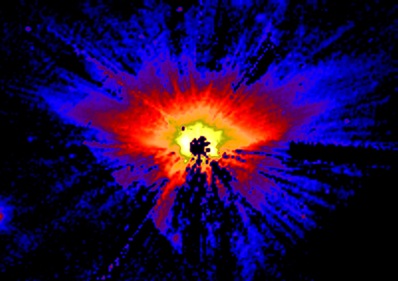
Debris discs warped by interstellar wind
DR EMILY BALDWIN
ASTRONOMY NOW
Posted: August 28, 2009


The curious shapes of some potentially planet harbouring dust-filled discs around stars could be explained by interactions with the local interstellar gas.
The warps and bends in debris discs around other stars is often attributed to the presence of obscured planets or past encounters with a passing star. But the simple interaction between dust and interstellar gas could also explain the weird and wonderful shapes carved in the discs of young stellar systems.
 The inner (yellow) portion of HD 61005's disc spans a distance equivalent to the width of Neptune's orbit. This young star is located 100 light years away in the constellation Puppis. This false colour Hubble view masks the star's light in order to observe the details of the disc. Image: NASA/ESA/D. Hines (Space Science Inst., New Mexico) and G. Schneider (Univ. of Arizona).
The inner (yellow) portion of HD 61005's disc spans a distance equivalent to the width of Neptune's orbit. This young star is located 100 light years away in the constellation Puppis. This false colour Hubble view masks the star's light in order to observe the details of the disc. Image: NASA/ESA/D. Hines (Space Science Inst., New Mexico) and G. Schneider (Univ. of Arizona).
These primitive discs are packed with small asteroid- and comet-like bodies that have the potential to grow into planets through collisions. A side-effect of these collisions is the production of a vast quantity of fine dust. "This fine dust is usually removed through collisions among the particles, radiation pressure from the star's light and other forces," explains John Debes at NASA's Goddard Space Flight Center.
As a star moves through a galaxy it encounters thin gas clouds that create a kind of interstellar wind. "The drag from interstellar gas just takes them [the dust particle] on a different journey than they otherwise would have had," continues Debes. "The small particles slam into the flow, slow down, and gradually bend from their original trajectories to follow it." The force only effects the smallest particles, those that measure about one micrometre across – comparable to the size of smoke particles.
In a study of the dust disc of HD 32297, a 340 light year distant star in the constellation of Orion, a team of astronomers led by Debes noticed that the interior of the star's dust disc was warped. "Other research indicated there were interstellar gas clouds in the vicinity," says Debes. "The pieces came together to make me think that gas drag was a good explanation for what was going on."
In this scenario the debris disc can be sculpted into unique shapes as the interstellar wind bounces into the dust particles. If the collision is face-on, such as in the HD 61005 system, the edge of the disc bends gently away from the direction of motion, with fine dust trailing behind like a wake from a ship. In an edge-on collision a lop-sided disc would be formed.
"The drag from interstellar gas only affects the outskirts of the disc, where the star’s gravity can’t really hold onto the material," says team member Alycia Weinberger of the Carnegie Institution of Washington.
These 100 million year old systems resemble our own Solar System soon after the planets had formed, and although it is not known if planets lurk in the discs of the two systems highlighted in this study, a better understanding of processes affecting the outer edges of these dusty reservoirs could shed light on how ice giants like Uranus and Neptune, and the depository of smaller bodies such as the Kuiper Belt objects, arose in the Solar System.
"It looks like interstellar gas helps young planetary systems shed dust much as a summer breeze helps dandelions scatter seeds," concludes Goddard-based team member Marc Kuchner.
|



